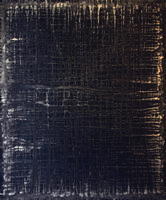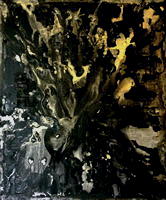Symphonic Poem in Black and Gold
Symphonic Poem in Black and Gold challenges the traditional concepts of boundary and orientation in painting in several ways. The two canvases of the diptych are not joined; each is meant to be framed and hung separately. There is no designated "top" or "bottom" to each canvas ~ in fact, the painting can be hung with each of the canvases oriented horizontally or vertically; and neither canvas is specified as "right" or "left". Ultimately, they could be hung one above the other. The placement of the components of the painting is contingent on the inherent qualities of the site where it is hung.
At first look, the two canvases seem mismatched. While the restricted palette unites the two, the visage of the canvases seems incongruous to each other. On closer examination, however, the grid-like pattern of one canvas is seen to be the foundation of the other: the experience of one side of the painting supports the experience of the other and together, they describe a linear progression. While one canvas is dynamic (it draws the immediate attention with its explosiveness), the other canvas opens delicately upon quiet examination and gives the eye ~ and the psyche ~ a place to rest. Each side of the diptych balances the other through yin and yang qualities (the "yin" canvas painted with yang qualities [straight lines]; the "yang" canvas painted with yin qualities [rounded lines]), creating a fluid movement of energy between the canvases by drawing the eye to one and then the other and back again.
The execution of the painting is a collaboration between artist and medium interacting with the laws of chance and physics. Metallic powder and large amounts of water added to the paint contribute to the unpredictability of the result, as do inconsistencies in the canvas and stretchers. The finished artwork is the product of the semi-random movement of multiple layers of paint and metallic powder, each with an extended drying time, and the sure hand of the artist.
This artwork, though, reveals the hand of many artists, from the painter, to the fates and gravity, to the curator, and ultimately, the viewer. It co-exists with the site in which it is placed and, hopefully, the company it keeps…
The Symphonic Poem series of paintings relates to the architectural aspect of music, the structure and complexity of classical forms of music and, quite possibly, the architecture that music fills. Symphonic Poem in Black and Gold describes a musical construction of two movements, each of which carries motifs of the other. In one sense, it builds to a crescendo; in another, it deconstructs itself to a simple, lyrical beauty; a loud movement and a soft movement, in whichever order it is experienced.
The black and metallic gold colors describe music as electricity in the void of space; a spark of creativity in the depth of the soul. The painting crackles with life, with excitement, even on the more sedate side of the diptych ~ quite possibly more so on the quieter side of the diptych as the tension of its structure seems so biological, so full of the potential for life…
From the introduction to Symphonic Poems:
These paintings extend the abstract expressionist tradition of Jackson Pollack and Mark Rothko. Non-narrative in format, the paintings are windows onto the biological soul and are reflections of a moment in time ~ they are not meant to be referential, they are not meant to be sentimental; they are meant to be held in quiet contemplation just as if one were sitting at a symphonic concert. If the experience of the moment could be conveyed in words, the paintings would not need to exist. But the moment cannot be conveyed in words. Thus the universe of these paintings.
Symphonic Poem in Black and Gold (2010)
Roy Anthony Shabla
Latex and metallic powder on primed canvas
Each canvas 6’ x 5’
galleRoy.com
RoyAnthonyShabla.com


